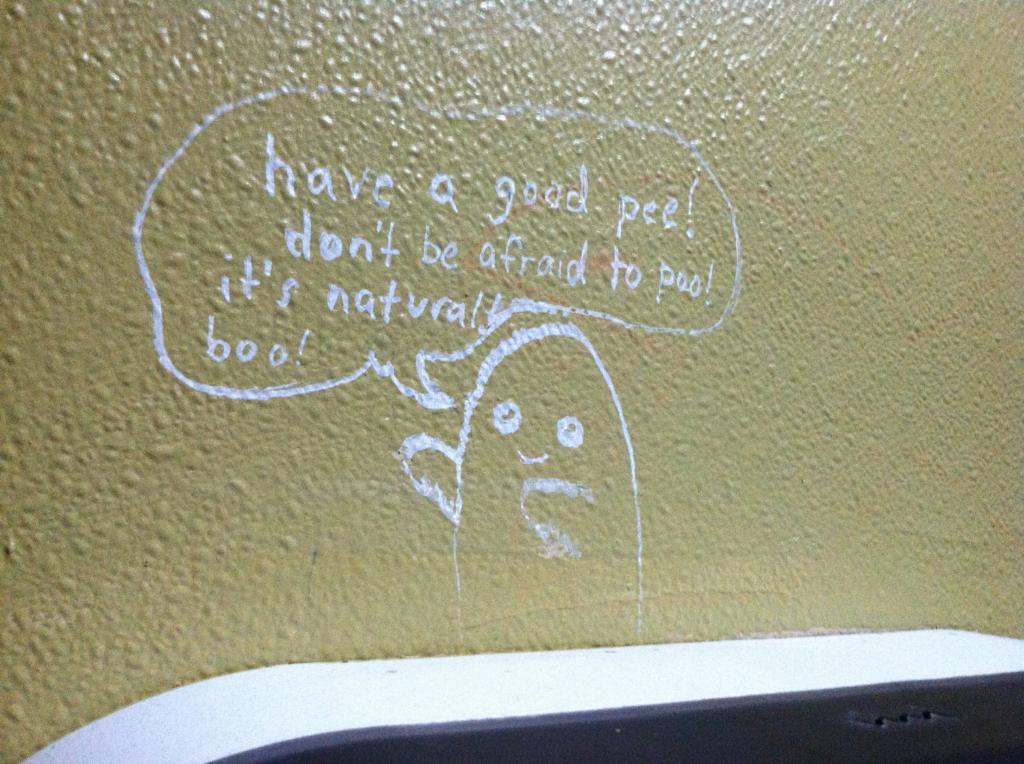The History of Bathroom Stall Graffiti

Bathroom stall graffiti, those cryptic messages and drawings etched onto the walls of public restrooms, is a ubiquitous feature of modern life. It’s a form of communication that transcends age, class, and cultural boundaries, offering a glimpse into the collective subconscious of society. But where did this unique art form originate, and what are its cultural implications?
Early Forms of Bathroom Stall Graffiti
The origins of bathroom stall graffiti can be traced back to ancient times. Early examples of this art form can be found in public restrooms of ancient Rome and Greece, where people would inscribe messages and drawings on the walls. These early forms of graffiti were often political in nature, expressing discontent with the ruling class or celebrating the achievements of local heroes. However, they also included personal messages, such as love poems and declarations of affection.
The Rise of Modern Bathroom Stall Graffiti
The modern era saw a significant shift in the nature and content of bathroom stall graffiti. With the rise of mass media and popular culture, the messages and images found in public restrooms became increasingly influenced by contemporary trends and events. During the 1960s and 1970s, bathroom stall graffiti became a powerful tool for political expression, particularly among students and young adults who were protesting the Vietnam War and social injustices.
Cultural Significance of Bathroom Stall Graffiti
Bathroom stall graffiti has become an integral part of popular culture, reflecting the anxieties, hopes, and aspirations of society. It provides a unique platform for anonymous expression, allowing individuals to share their thoughts and feelings without fear of reprisal. It also serves as a valuable historical document, offering insights into the social, political, and cultural landscape of different eras.
The Nature of Bathroom Stall Graffiti: Best Bathroom Stall Graffiti

Bathroom stall graffiti, that art you see scribbled on the walls of public restrooms, is more than just random doodles. It’s a fascinating window into human behavior, revealing a lot about our motivations, social dynamics, and even our anxieties.
Motivations Behind Bathroom Stall Graffiti
Bathroom stall graffiti is often seen as a form of rebellion, a way for individuals to express themselves in a space where they feel anonymous. It can be a way to vent frustrations, share humor, or simply pass the time.
- Anonymity: The bathroom stall offers a sense of privacy and anonymity, allowing individuals to express themselves without fear of judgment or repercussions. This anonymity can be particularly appealing to those who are shy or introverted, or those who want to express controversial or unpopular opinions.
- Humor and Entertainment: Bathroom stall graffiti is often humorous, providing a chuckle for those who stumble upon it. It can be a way to break the monotony of a mundane day or to share a joke with strangers.
- Social Commentary: Some bathroom stall graffiti takes on a more serious tone, offering social commentary or criticism of current events. This can be a way for individuals to express their political views or to raise awareness about important social issues.
- Personal Expression: Bathroom stall graffiti can also be a way for individuals to express their personal thoughts, feelings, and experiences. This can be a way to process emotions, to connect with others, or simply to leave a mark on the world.
Forms and Styles of Bathroom Stall Graffiti
The appearance of bathroom stall graffiti can vary widely, ranging from simple scribbles to elaborate drawings.
- Text: The most common form of bathroom stall graffiti is text. This can range from simple messages like “I was here” to elaborate poems, song lyrics, or philosophical musings.
- Drawings: Some bathroom stall graffiti takes the form of drawings, ranging from stick figures to detailed portraits. These drawings can be humorous, satirical, or even deeply personal.
- Symbols: Bathroom stall graffiti can also include symbols, such as hearts, stars, or other iconic images. These symbols can be used to convey emotions, ideas, or simply to add visual interest to the graffiti.
Themes and Topics in Bathroom Stall Graffiti, Best bathroom stall graffiti
The themes and topics explored in bathroom stall graffiti are diverse, reflecting the wide range of human experiences and perspectives.
- Humor: Humor is a common theme in bathroom stall graffiti, often taking the form of puns, jokes, or satirical observations.
- Social Commentary: Bathroom stall graffiti can also serve as a platform for social commentary, addressing issues such as politics, social injustice, and cultural trends.
- Personal Expressions: Some bathroom stall graffiti is deeply personal, reflecting the writer’s thoughts, feelings, and experiences. This can include love poems, confessions, or simply a reflection on life.
The Impact of Bathroom Stall Graffiti

Bathroom stall graffiti, often dismissed as mere vandalism, holds a surprising level of influence. It can act as a reflection of societal issues, a platform for social commentary, and even a driver of cultural trends. Its impact extends beyond the confines of the bathroom, reaching into the broader public discourse and shaping our understanding of the world around us.
The Cultural Impact of Bathroom Stall Graffiti
Bathroom stall graffiti offers a unique window into the collective consciousness of a society. It serves as a platform for expressing opinions, sharing anxieties, and commenting on current events. By examining the themes and messages found in bathroom stall graffiti, we can gain valuable insights into the cultural landscape.
- Social Commentary: Bathroom stall graffiti often reflects societal anxieties and concerns. For example, during periods of economic instability, messages about financial struggles and job insecurity might be prevalent. Similarly, during political campaigns, graffiti may express support for or opposition to particular candidates or policies.
- Humor and Entertainment: Bathroom stall graffiti often serves as a source of humor and entertainment. It can provide a lighthearted escape from the pressures of everyday life and offer a sense of camaraderie among those who encounter it. Many messages are witty, satirical, or simply silly, providing a break from the mundane.
- Subcultures and Identity: Bathroom stall graffiti can also reflect the presence of specific subcultures or groups within a society. For example, graffiti containing references to music genres, fashion trends, or slang terms can indicate the presence of a particular youth subculture.
The Ethical and Legal Considerations
While bathroom stall graffiti can be a powerful form of expression, it also raises ethical and legal concerns. The act of writing on bathroom stall walls is generally considered vandalism, which can carry legal consequences. However, the issue of freedom of expression complicates the matter.
- Vandalism vs. Freedom of Expression: The line between vandalism and freedom of expression is often blurred in the context of bathroom stall graffiti. While the act of writing on private property is technically vandalism, some argue that the content of the graffiti can be considered a form of protected speech.
- Legal Consequences: Depending on the severity of the damage and the content of the graffiti, individuals caught vandalizing bathroom stalls can face fines, community service, or even jail time. However, the legal response to bathroom stall graffiti can vary significantly depending on local laws and the specific circumstances.
- Ethical Considerations: The ethical implications of bathroom stall graffiti are complex. Some argue that it is disrespectful to damage property, even if the content is harmless. Others contend that the act of writing on bathroom walls can be a form of rebellion against authority or a way to express feelings that cannot be expressed in other ways.
The Influence on Public Opinion and Cultural Trends
While bathroom stall graffiti is often dismissed as insignificant, it can have a surprising influence on public opinion and cultural trends. Its ability to spread ideas and provoke discussion can contribute to the emergence of new social movements or the amplification of existing ones.
- Spreading Awareness: Bathroom stall graffiti can be a powerful tool for raising awareness about social issues. Messages about inequality, discrimination, or environmental concerns can reach a wide audience and spark conversation.
- Fueling Social Movements: In some cases, bathroom stall graffiti has been used to promote social movements or protest against injustice. For example, during the civil rights movement, graffiti messages advocating for equality and justice were found in bathrooms across the country.
- Cultural Trends: Bathroom stall graffiti can also influence cultural trends by introducing new slang terms, catchphrases, or memes into the public consciousness. These expressions can then spread through social media and other channels, becoming part of the broader cultural landscape.